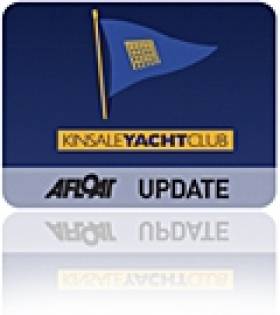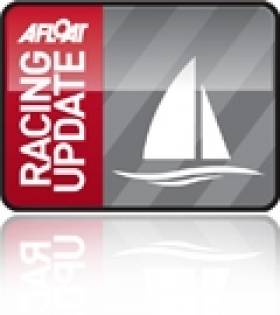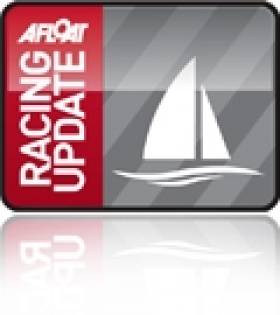Displaying items by tag: Quarter Ton Cup
Sovereigns Cup Aiming for 140 Entries
Entries are coming in at a good pace for The Sovereign's Cup the South coast sailing event takes place from 22nd-25th June 2011 in the outer harbour of Kinsale, Co Cork.
"We are delighted with the entry level to date and are now encouraging boats to enter The Sovereign's Cup on our website www.sovereignscup.com or by calling Kinsale Yacht Club directly on (021) 4773433. Already, skippers are beginning to plan their sailing events for the year and we hope that they will favourably consider us here in Kinsale," said Gary Horgan, Regatta Director.
"Additionally, this year, the Dun Laoghaire to Dingle race and ICRA Championships in Cork just before The Sovereign's Cup should act as good feeders as boats will be down south. As well as the excellent sailing conditions, race management and social programme ashore, there is a good discounted entry fee for the first 100 entries, which is already proving very attractive to entrants. Also, we are encouraging people to start thinking about their travel and accommodation plans and are delighted that the Cork Swansea ferry will enable more sailors to access Kinsale easily from the UK," he added.
The Sovereign's Cup was established in 1995 as and has been a very successful and hugely popular cruiser regatta. The biennial event attracts over 140 boats from all over Ireland and the UK who compete for the prestigious Sovereign's Cup for best all round score in IRC and The Portcullis Trophy for best progressive handicap.
There are many Classes for entry; including Class 0, 1, 2, 3, 4 and two White Sails classes. Also, the Quarter Ton Class Championships will be taking place during the Sovereign's Cup, bringing many new visitors to Kinsale from the South of England and Wales in particular.
According to Ian Travers of the Sovereign's Cup Committee at KYC, interest has been phenomenal and he has received plenty of calls from UK and Irish owners expressing their interest.
"Also, I have received confirmation that a quarter tonner named 'Black Fun' is to be shipped from New Zealand to Europe this year and is intent on making it to Kinsale for the Sovereign's Cup! We are confident that there will be around 25-30 quarter tonners participating in the Sovereign's Cup this year," said Ian Travers.
For more information on The Sovereign's Cup, contact Kinsale Yacht Club on (021) 4773433 www.kyc.ie or www.sovereignscup.com
Take a look back at Bob Bateman's photos from Sovereigns Cup 2003, Sovereigns Cup 2005 and Sovereigns Cup 2007 in our photo reviews
Click this link for all the lastest Sovereigns Cup news from Afloat.ie
Cote Tops Quarter Ton Cup Fleet
Sun, wind, great competitors and a tense finish that went right down to the closing seconds of the final race made the final day of the Coutts Quarter Ton Cup 2010 an absolute stunner.
After nine races in conditions that tested the competitors to the max the worthy and very popular winner is the 1990 Gonzalez designed Cote owned by Darren Marston and Olly Ophaus and crewed by Rob Dyer, Dave Lenz and Chris Cooper. Top Irish finisher was Tiger, sailed by the youngest crew in the event, headed up by George Kenefick and George Kingston
Long-term supporters of the Quarter Ton Class, Darren and Olly purchased Cote in a very sorry state in winter 09/10 and have spent many hours restoring her to concourse condition. At the prize giving Darren Marston thanked his fellow competitors for an outstanding regatta and made a heartfelt and emotional speech in which he paid tribute to the many people racing this week who had helped and supported him in his sailing career, to the organisers of the event, to the sponsor Coutts and to his crew.
Going into the final day Peter Morton's Anchor Challenge, designed by Bruce Farr in 1980 and crewed by Kelvin Rawlings, John Newnham, Stuart Childerley and Jason Carrington, led the regatta by a narrow 1.5 point margin from Cote with John Greenwood aboard Rob Gray's 1990 Vrolik design Aquila third, Louise Morton sailing Anchor Challenge's sister ship Espada fourth, Bullet, designed by Fauroux in 1982 fifth and Ian Southworth's Whiskers, a 1979 Joubelt Nivelt, in sixth.
The Race Committee delivered on their promise to run three final races - races seven to nine of the series - and laid on two excellent windward leeward courses followed by a final Solent round the cans course with a spectacular running finish off Cowes. With every race there were changes on the leader board. Cote opened with a win whilst Anchor Challenge took a second putting Cote into the lead by half a point. Espada came third in moving them up into third place overall with Aquila now fourth and Whiskers fifth.
Race eight proved to be the pivotal point in the regatta for more reasons that one. As the boats came round the second weather mark Cote led Anchor Challenge round the mark and the two boats had a comfortable lead on the pack. Anchor Challenge's kite set went well and they were looking pretty confident until a massive gust came rolling down off the shore just as bowman Jason Carrington was tidying away the jib. Within seconds the foredeck was awash and the boys were on their way to giving the fleet a master class in how to complete the perfect Chinese gybe. With the exception of the ever canny John Newnham the entire crew ended up getting a soaking and crucially it was some time before they could get the boat righted and the kite down. They immediately re-hoisted and were back on track but those vital seconds meant that they could only manage a fourth place while Cote went on to win the race. Cote now led the regatta by 2.5 points from Anchor Challenge as they prepared for one last race.
Sadly bad luck was running in the Morton family in that penultimate race and Louise Morton found herself the wrong side of the line in the closing minute of the start and subject to a 20% Z flag penalty. Her 28 point score dropped her from third down into sixth, leaving Aquila in third, Whiskers four and Bullet fifth.
The final round the cans race was an absolute cliffhanger with tidal gates, wind shifts and velocity variations galore. For the leading pack it was perhaps one of the closest races of the regatta. At each mark competitors and spectators alike tried to calculate the corrected times and there was much worried glancing back over shoulders. The final run all the way from the Hill Head shore to the finish off Cowes was neck and neck and only feet separated the leading half dozen as the crossed the finish line. As they crossed they looked back to see the chasing pack coming down on a building breeze and the stopwatches were out in force. Once the calculations had been made Whiskers was the race winner with Tony Dodd's Purple Haze second, Aquila third, Cote fourth, Anchor Challenge fifth, Bullet sixth and Espada seventh.
Cote were declared the worthy winners of the 2010 Coutts Quarter Ton Cup with Anchor Challenge second, Aquila third, Whiskers fourth, Bullet fifth and Espada sixth. At the prize giving Stephen Kemp of title sponsor Coutts presented the prizes and thanked the Quarter Ton Class for a wonderful four year partnership and looked forward to many more years of association with the Quarter Tonners.
Alongside the main prizes there were also a number of special presentations. The Ron Holland Trophy for the top production boat went to Richard Thomas's Bolero Sergeant Pepper, the Concourse de Elegance, awarded by the Race Committee was won by Phoenix owned by the Welch/Thompson/Manser/Flemming partnership, the oldest bowman award went to Pete 'Hovis' Briant , and a special award for the boat completing the most broaches during the regatta - a fetching lime green mask and snorkel - went to Mike Webb and Tom Bailey's Flashheart.
Thanks must go to sponsors Coutts, the Royal Corinthian Yacht Club and its race management team and of course to the competitors themselves for making this perhaps the best Coutts Quarter Ton Cup revival event yet. Here's to next year!
Provisional Overall Top Ten Overall
1 Cote - Darren Marston and Olly Ophaus - 17 points
2. Anchor Challenge - Peter Morton - 21.5 points
3. Aquila - John Greenwood/Rob Gray - 30 points
4. Whiskers - Ian Southworth - 37 points
5. Bullet - Howard Sellars & Mike Till - 48 points
6. Espada - Louise Morton - 58 points
7. Tiger - George Kenefick and George Kingston
8. Illegal Immigrant - Willy McNeill & Mike Pascall
9. Diamond - Graydon and Thomas Dawson
10.Sergeant Pepper - Richard Thomas
Tiger Roars into Quarter Ton Cup Top Ten
The team on board Tiger have leapt into the top ten overnight with a string of top ten results at the Coutts Quarter Ton Cup in the Solent. The Cork-based boat counted a 4-5-14-6 scoreline in the last four races to push them into 7th overall after day two, the top Irish boat by sixteen places. The results are HEREand the event has a well-updated blog (HERE) that features a vide interview with the Tiger crew which, bizarrely, is marked as a private video and is only viewable by invitation.
Day two of the Coutts Quarter Ton Cup, hosted by the Royal Corinthian Yacht Club, Cowes, brought some of the most challenging conditions the Solent can deliver - with a rapidly shifting and gusting wind from the North East fluctuating in strength from single figures up towards 20 knots. Add a strong spring tide which changed direction in the middle of racing and the 35 competing boats had their work cut out. "The cream of the tacticians certainly rose to the top today!" Quarter Ton Class Secretary and skipper of Espada Louise Morton commented wryly after sailing, "I can't quite believe that we have 35 boats competing, although it feels like a hundred when you have to cross behind them all on port, which is what we had to do today." PRO Bob Milner and his team were on a mission and had forewarned the competitors of their intention to run four races today to catch up the schedule following the abandonment of yesterday's attempted third race. Good to their word they laid on three windward leeward races in the Hill Head area of the central Solent followed by a final round the cans race taking the competitors back to finish off Cowes. With six races completed it's been snakes and ladders on the leader board and with the discard still to kick in (it comes into play after seven races) there's still plenty more climbing and sliding to come on tomorrow's final day. Peter Morton sailing the 1976 Farr designed Anchor Challenge with bowman Jason Carrington, pitman Kelvin Rawlings, trimmer John Newnham and tactician Stuart Childerley has jumped into a 1.5 point lead thanks to an outstanding day with a 1, 3.5, 1, 1 scoreline. Lying in second place on 17 points having added 3, 1, 3, 2 to their score is Darren Marston and Olly Ophaus's 1990 Gonzalez design Cote with tactician Dave Lenz, trimmer Rob Dyer and pitman Chris Cooper (Darren helms and Olly does the bow). Although they had an excellent day afloat the boys joined the emergency boat repair club tonight as they affected repairs to the anchor points on their pushpits which were starting to give way (we're not sure if this is because they are hiking harder than everyone else or just that they've eaten more pies!).
Currently in third place on 34 points, but looking forward to the completion of race seven and the instigation of the discard,as they are counting a 16th place thanks to a Z flag penalty, is John Greenwood and his crew of tactician David Howlett, Andy McClelland, Brett Aarons and Dan Gottz sailing Rob Gray's 1990 Vrolick design Aquila. Alongside the Z-flag their other scores today were 2, 2, 2, 11 which moved them nicely up from last night's sixth overall. Louise Morton and her all girl crew of Josie Gibson, Vicky Lenz, Charlotte Lawrence, Collette Blair and Nicky McGregor had a very consistent day and have moved up from fifth into fourth on 47 points. They got the day off to a fair start with a ninth in race three but stumbled in race four where they could only manage joint 20th, largely thanks to that bad start Louise mentioned in our opening paragraph, before recovering a little to finish sixth and eighth to close the day. Overnight leader Whiskers is another boat that can't wait for the discard to kick in after they were OCS and also blew up a jib track in the third race. forcing them to withdraw and get the toolbox on deck once again They subsequently went on to score 6, 5, 5 so while they have currently dropped down into sixth place overall on 58 points if they can do well tomorrow and drop that DNF/36 they are still in with a good chance of making the podium.
For Howard Sellars and Mike Till aboard Bullet, a 1978 Fauroux, it was a day of mixed fortunes.
Having gone into the day lying second they now find themselves in fifth, seven and a half points ahead of Whiskers. Tactician Henry Bagnall summed things up perfectly saying "It just wasn't our day, we just couldn't seem to find a clear lane and when ever we wanted to go somewhere we found someone else had got there just before us. It was definitely one of the toughest Solent days I've seen." As always the action has been fleet wide and perhaps the most spectacular action of all came from Flashheart, the 1978 Dubois designed Starflash owned by Mike Webb and Tom Bailey. A bunch of dinghy and big boat sailors they are the first to admit that they are on a steep learning curve with the Quarter Tonner (although as the son of George and nephew of Jim Webb, both legendary Quarter Ton sailors and builders, Quarter Ton sailing is in Mike's blood). Today the boys just couldn't quite seem to remember the old adage about keeping the aluminium above the plastic and their pirouetting and horizontal side slides kept the photo boats busy on a regular basis. Below is their best effort of the day, which won them a bottle of Mount Gay Rum at tonight's prize giving.
Another young competitor with Quarter Tonners in his blood is Ireland's George Kenefick, son of the infamous Neil Kenefick of Manzanita fame, who with co-owner George Kingston and crew Nathan Kirwan, Donagh Good and Dian Twomey is sailing the 1989 Faroux design Tiger (formerly ASAP). The boys got their regatta off to a slightly wobbly start yesterday and were lying in 14th overnight. But today this enthusiastic young crew found their form and thanks to a 4, 5, 14, 6 score they were not only the fourth best performers of the day but have also moved up into seventh overall. This young crew are always up for some craic as can be seen from their media information form which tells us nothing about their sailing skills but does advise us that pitman Denis Good is the current "Best Fishmonger On The Irish South Coast".
This evening the sailors have been enjoying the traditional Coutts Quarter Ton Cup Gala Dinner. Always a highlight of the event this year's after dinner speaker was the New Zealand sailing guru Roy Dickson. Winner of the One Ton Cup, the Quarter Ton Cup, championships in multiple classes and even two Round The Isle of Wight Races as well as a participant in numerous America's Cups, Roy regaled his audience with some incredible tales of how he came to take part in that winning Quarter Ton Cup - a complete accident he assures us - and of the regatta itself. He also praised the Quarter Ton Association for its outstanding work in reviving the class and thanked his team members for giving him the chance to sail in a Quarter Tonner once again. He did point out that he was breaking three of his personal rules in being here: A) That you should never go back. B) That you should never sail on a boat whose length in feet is less than your age - and at 78 years he acknowledges he is more than 60% out on this one. And finally C) That he never makes speeches. His audience were delighted that he had agreed to break all three of these rules to join them on the water and entertain them this evening and gave him a rousing reception. The regatta concludes tomorrow and with good winds forecast and plenty more races to come (the NOR allows for up to 12 races) we can expect a nail-biting finish.































































